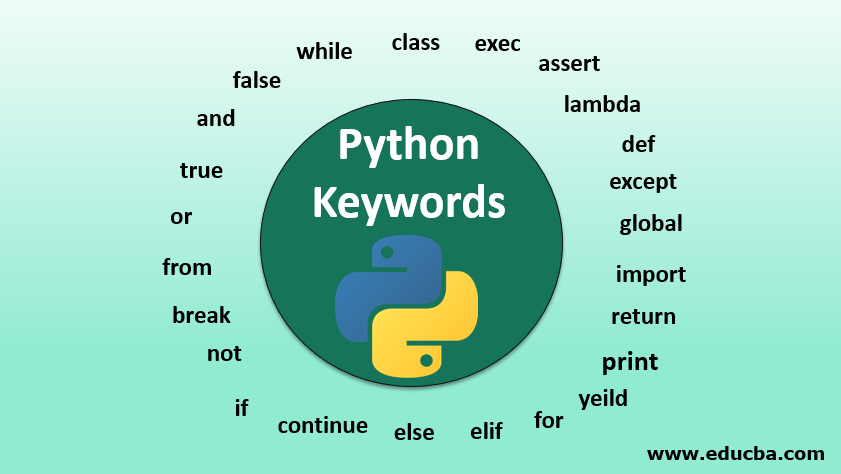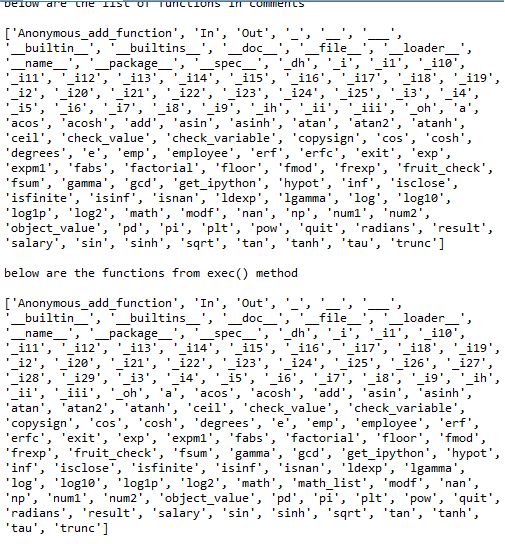
Introduction to Python Keywords
Keywords in any programming language can be defined as words specifically used for certain functions or representing explicit program operations. These keywords in the code cannot be treated as common English words for their direct meaning. In Python, there are approximately around thirty-three (33) keywords, and a few of the keywords generally used in the program coding are break, continue, true, false, and, or, not, for, while, def, class, if, else, elif, import, from, except, exec, print, return, yield, lambda, global, etc.
Top 24 Keywords of Python
Python keywords have unique meanings and are essential for defining the language’s syntax and structure. If you need help with Python assignment tasks, understanding these keywords is crucial, as they form the building blocks of your scripts. The following are the different keywords of Python:
1. and
The word ‘and is reserved for Boolean or logical operations. When implying this keyword, it means that an operation will be applied only when both conditions stand true.
Example:
check_value = 5
if check_value > 1 and check_value < 10:
print("Hello World!\n")
else:
print("Nothing to print")
Output:
2. or
The word ‘or’ is also reserved for Boolean or logical operations. When implying this keyword, it means that an operation will be applied even when one of the conditions stands true.
Example:
check_value = 5
if check_value > 1 and check_value < 10:
print("Hello World!\n")
else:
print("Nothing to print")
Output:
3. not
The word ‘not’ is also reserved for Boolean or logical operations. When implying this keyword, it means that an operation will be applied when the given conditional expression is not satisfied.
Example:
check_value = 5
if check_value not in [1,7,4,6]:
print("Hello World!\n")
else:
print("Nothing to print")
Output:
4. break
A break is a loop control statement. It helps to control the execution of the loops. Specifically, the break is responsible for terminating the execution of the loop.
Example:
fruits = ["apple", "banana", "cherry","jackfruit"]
for x in fruits:
if x == "apple":
continue
print(x)
if x == "banana":
pass
if x == "cherry":
break
print(x)
Output:
5. continue
Continue is a loop control statement. It helps to control the execution of the loops. Specifically, Continue is responsible for switching the loop control to the condition statement again.
Example:
def fruit_check(fruits) :
for x in fruits:
if x == "banana":
continue
if x == "cherry":
return
fruits = ["apple", "banana", "cherry"]
object_value = fruit_check(fruits)
print(object_value)
Output:
6. true
This keyword represents the Boolean value ‘true’.
Example:
check_string = '123'
print(check_string.isdigit())Output:
7. false
This keyword represents the Boolean value ‘false’.
Example:
check_string = 'asd'
print(check_string.isdigit())Output:
8. if
The if keyword represents a condition instance in python.
Example:
check_value = int(input(" Please enter the desired value : "))
if check_value < 3:
print ("list value : ", check_value)
Output:
9. else
The else keyword is used to represent the false execution of an if statement.
Example:
check_value = int(input(" Please enter the desired value : "))
if check_value < 3:
print ("list value : ", check_value)
else:
print("value is greater than 3")Output:
10. elif
The elif keyword represents the false execution with a different additional condition check for an if statement.
Example:
check_value = int(input(" Please enter the desired value : "))
if check_value < 3:
print ("list value : ", check_value)
else:
print("value is greater than 3")
Output:
11. for
The for a keyword is used to represent the for loop instance.
Example:
list = [1,2,3,4]
for i in list:
print(i)
Output:
12. while
The while keyword is used to represent the while loop instance.
Example:
check_value = int(input("Please enter the desired value : "))
while check_value < 10:
print(check_value)
check_value = check_value + 1
Output:
13. lambda
All anonymous functions are represented using lambda in python. Anonymous functions are actually orphan functions that don’t have any name associated with them. So they will be called using the variable value assigned to them.
Example:
Anonymous_add_function = lambda x, y : x + y
print("Anonymous function output value : ", Anonymous_add_function(2, 3))
Output:
14. def
The def keyword is used for defining a function or method in python programming. The function is a block of code that can be executed.
Example:
def fruit_check():
fruits = ["apple", "banana", "cherry"]
for x in fruits:
if x == "banana":
continue
if x == "cherry":
return
object_value = fruit_check()
# Function Call
print(object_value)
Output:
15. class
Classes allow bundling of functionality, A user-defined prototype for an object that defines a set of attributes that characterize any object of the class.
Example:
class employee:
Firstname ="Anand"
Lastname ="kumar"
def sample_func(self,salary):
print("Firstname : " ,self.Firstname)
print("salary : " ,salary )
salary=10000
emp = employee()
emp.sample_func(salary)
Output:
16. assert
A user-defined exception check in the program.
Example:
a = 2
try:
assert a < 2
print("end")
except AssertionError:
print("Assert error triggered")
Output:
17. except
An exception is an error occurring all through the execution of a program that interrupts the normal flow of the program’s instructions. Exception handling is the progression of capturing these exceptions and conducting them suitably. The except keyword is used for declaring the exceptions.
try: The try keyword is used to kick start the process of parsing the code for an exception.
finally: The final keyword is used to represent the block of code in the program, which needs to be mandatorily executed irrespective of the error checks.
Example:
try:
print("@@@@ PROGRAM TO CHECK EXCEPTION HANDELING @@@@")
Input1, Input2 = eval(input("Enter two numbers, separated by a comma :"))
#eval() will evaluate two inputs with comma sepearation is passed
result = Input1 / Input2
print("Output is ", result)
except ZeroDivisionError:
print("!!error in division - kindly verify the inputs !!")
except (IOError,TypeError):
print("!!Error with the input!!")
except SyntaxError:
print("Comma is missing. Enter numbers separated by comma like this 1, 2")
except :
print("!!ERROR!!")
else:
print("Exception not found")
finally:
print(" Finally section")
print(" !---------- END --------------!")
Output:
18. import
The import keyword is used for importing the necessary libraries into the program.
Example:
import math
# In the below given example we have used math.pi library for importing pi constant
print( math.pi )
Output:
19. from
The import keyword is used for importing the necessary libraries into the program.
Example:
from math import pi
# In the below given example we have used math.pi library for importing pi constant
print( pi )
Output:
20. global
The global keyword is used to modify the scope of the given variable. Usually, mentioning a variable as global alters the variable scope from a local instance to a universal instance. So this means the variable will be available for access through the entire program at all possible instances.
Example:
check_variable = 0 # global variable
def add():
global check_variable
check_variable = check_variable + 2 # increment by 2
print(" Value Inside add() function: ", check_variable)
add()
print(" Value In main function :", check_variable)
Output:
21. exec
The functions are intended for the vibrant implementation of the Python program, which can be object code or a specific string. In the case of a string, the string is parsed as a group of Python statements, which intern is executed until any python oriented errors are populated in the program in an object code perspective, just a static execution has been carried out. We have to be cautious so that the go-back statements might not be worn external of function definitions that are not still contained by the background of code agreed to the exec() function. Additionally, instead of returning any value, it actually returns None.
Example:
from math import *
print("below are the list of functions in comments")
print(" ")
math_list = ['Anonymous_add_function', 'In', 'Out', '_', '__', '___', '__builtin__', '__builtins__', '__doc__', '__file__', '__loader__', '__name__', '__package__', '__spec__', '_dh', '_i', '_i1', '_i10', '_i11', '_i12', '_i13', '_i14', '_i15', '_i16', '_i17', '_i18', '_i19', '_i2', '_i20', '_i21', '_i22', '_i23', '_i24', '_i25', '_i3', '_i4', '_i5', '_i6', '_i7', '_i8', '_i9', '_ih', '_ii', '_iii', '_oh', 'a', 'acos', 'acosh', 'add', 'asin', 'asinh', 'atan', 'atan2', 'atanh', 'ceil', 'check_value', 'check_variable', 'copysign', 'cos', 'cosh', 'degrees', 'e', 'emp', 'employee', 'erf', 'erfc', 'exit', 'exp', 'expm1', 'fabs', 'factorial', 'floor', 'fmod', 'frexp', 'fruit_check', 'fsum', 'gamma', 'gcd', 'get_ipython', 'hypot', 'inf', 'isclose', 'isfinite', 'isinf', 'isnan', 'ldexp', 'lgamma', 'log', 'log10', 'log1p', 'log2', 'math', 'modf', 'nan', 'np', 'num1', 'num2', 'object_value', 'pd', 'pi', 'plt', 'pow', 'quit', 'radians', 'result', 'salary', 'sin', 'sinh', 'sqrt', 'tan', 'tanh', 'tau', 'trunc']
print(math_list)
print(" ")
print("below are the functions from exec() method")
print(" ")
exec("print(dir())")
Output:
22. print
The print keyword is used for displaying output in the terminal.
Example:
import math
print( " !PYTHON CONSTANS! ")
print(" PI value : " , math.pi)
print(" E value : " , math.e)
print(" nan value : " , math.nan)
print(" E value : " , math.inf)
Output:
23. return
The return keyword is used to return some value as a function’s output. If no return value is specified, a function by default returns none.
Example:
def fruit_check(fruits) :
for x in fruits:
if x == "banana":
continue
if x == "cherry":
return x
fruits = ["apple","cherry","banana" ]
object_value = fruit_check(fruits)
print(object_value)
Output:
24. yield
The yield declaration hangs up function’s implementation, in addition, to propel a value to the respective caller, but retains an adequate amount of circumstances to facilitate function to take up again anywhere it is missing off. When recommence, the function carries on execution right away following the most recent yield run. This permits its system to construct a sequence of standards over time. Rather, they calculate at once and send them back like a list.
Example:
def yieldFun():
yield 1
yield 2
yield 3.
# Driver code to check above generator function
for value in yeildFun():
print(value)Output:
Conclusion – Python Keywords
Python holds a very sophisticated set of reserved words with it. The major advantage of this programming language is that it holds fewer keywords, making it a very efficient programming outfit to choose upon.
Recommended Articles
We hope that this EDUCBA information on “Python Keywords” was beneficial to you. You can view EDUCBA’s recommended articles for more information.












